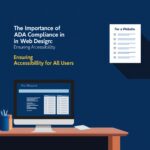Practical Tips for Designing Accessible Websites is a crucial aspect of web design that ensures equal access to the website’s content for all users, including those with disabilities. Web accessibility is not only a legal requirement but also a moral obligation for businesses and organisations. People with disabilities face many difficulties in accessing websites that are not designed with accessibility in mind. By designing accessible websites, web designers can make a positive impact on the lives of millions of people.
Web accessibility is not a new concept, and there are many guidelines and best practices available to web designers. However, many websites still fail to meet even the basic accessibility requirements. Designing accessible websites requires a deep understanding of the needs of people with disabilities and the ability to implement the necessary changes in the design process. Web designers need to be aware of the accessibility guidelines and incorporate them into their design process to ensure that their websites are accessible to all.
In this article, we will discuss some practical tips for designing accessible websites. These tips are based on the Web Content Accessibility Guidelines (WCAG) and are designed to help web designers create websites that are accessible to all users, including those with disabilities. We will cover topics such as colour contrast, font size, alt text, and keyboard accessibility. By following these tips, web designers can create websites that are accessible and inclusive for all users.
Understanding Website Accessibility
Website accessibility refers to the practice of designing and developing websites that can be used by people with disabilities. This includes people with visual, auditory, physical, and cognitive disabilities. The Americans with Disabilities Act (ADA) requires that websites be accessible to people with disabilities, and failure to comply with the ADA can result in legal action.
To ensure that websites are accessible, designers and developers should follow the Web Content Accessibility Guidelines (WCAG). The WCAG are a set of guidelines developed by the World Wide Web Consortium (W3C) that provide a framework for making web content more accessible to people with disabilities. The guidelines are organized into three levels of conformance: A, AA, and AAA. Conformance at level AA is generally considered the minimum level of accessibility required by the ADA.
There are many aspects of web accessibility that designers and developers should consider. For example, websites should be designed with clear and consistent navigation, and should include alternative text for images and other non-text content. Websites should also be designed with appropriate colour contrast, and should be compatible with screen readers and other assistive technologies.
In addition to following the WCAG, designers and developers should also consider the needs of disabled people when designing websites. This includes considering how people with disabilities use the web, and designing websites that are easy to navigate and use. By following these guidelines and considering the needs of disabled people, designers and developers can create websites that are accessible to everyone.
Importance of Inclusivity in Web Design
Inclusivity in web design is crucial for creating websites that are accessible to everyone, regardless of their abilities. The goal of inclusivity is to ensure that all users have an equal opportunity to access and interact with the content on a website. This includes users with disabilities, as well as those who may have different needs or preferences when it comes to using the web.
Inclusivity is an essential part of user experience (UX) design. By designing with inclusivity in mind, designers can create websites that are more user-friendly and easier to navigate. This can lead to better engagement and increased satisfaction among users.
Inclusivity should be considered throughout the entire web design process, from the initial planning stages to the final implementation. This includes everything from user interface (UI) design to visual design to web development. Designers should be aware of the different needs and abilities of their users and strive to create a website that is accessible to as many people as possible.
One of the most important aspects of inclusivity in web design is ensuring that the website is accessible to users with disabilities. This can include users with visual impairments, hearing impairments, motor impairments, and cognitive impairments. Designers should be aware of the different assistive technologies that these users may use, such as screen readers, and ensure that their website is compatible with these technologies.
Inclusivity in web design is not only important for users with disabilities, but for all users. By creating a website that is accessible to everyone, designers can create a better user experience for all users. This can lead to increased engagement, higher satisfaction, and ultimately, a more successful website.
Designing for Various Disabilities
Designing an accessible website involves considering the needs of users with different disabilities. The following are some practical tips for designing accessible websites for users with various disabilities:
Visual Impairments
Users with visual impairments face difficulties in perceiving web content. Designers can make web content more accessible for visually impaired users by:
- Providing alternative text (alt text) for images, which can be read by screen readers.
- Using clear and easy-to-read fonts and colours for text, with sufficient contrast between the text and background.
- Providing audio descriptions or transcripts for videos.
- Using descriptive link text that provides context about the link’s destination.
Colour Blindness
Colour blindness is a common visual disability that affects users’ ability to differentiate between colours. Designers can make web content more accessible for colour-blind users by:
- Using colours that have a high contrast ratio and are distinguishable from each other.
- Avoiding the use of colour alone to convey information.
- Providing text labels or patterns in addition to colours to differentiate between elements.
Mobility Disabilities
Users with mobility disabilities face difficulties in using a mouse or keyboard to navigate a website. Designers can make web content more accessible for users with mobility disabilities by:
- Providing keyboard shortcuts for all website functions.
- Ensuring that all interactive elements are accessible via keyboard.
- Using clear and consistent navigation menus that are easy to access and use.
Auditory and Speech Disabilities
Users with auditory and speech disabilities face difficulties in perceiving audio content and using voice-based interfaces. Designers can make web content more accessible for users with auditory and speech disabilities by:
- Providing captions or transcripts for audio content.
- Using clear and concise language that is easy to read and understand.
- Providing visual cues for voice-based interfaces.
Physical Disabilities
Users with physical disabilities face difficulties in using a mouse or keyboard to navigate a website. Designers can make web content more accessible for users with physical disabilities by:
- Providing alternative input methods, such as voice recognition or eye-tracking technology.
- Ensuring that all interactive elements are accessible via keyboard.
- Using clear and consistent navigation menus that are easy to access and use.
Essential Elements of Accessible Websites
When designing accessible websites, there are several essential elements to consider. These elements ensure that all users, regardless of their abilities, can access and use the website effectively. The following are some of the most important elements to consider:
1. Images
Images are an important part of web design, but they can also cause accessibility issues. To make images accessible, designers must include alternative text, or “alt text,” that describes the content of the image. This allows users who cannot see the image to understand what it contains.
2. Links
Links are another important element of web design, but they can also be difficult for some users to access. To make links accessible, designers should ensure that they are clearly labeled and easy to click. They should also avoid using links that open in new windows, as this can be confusing for users who rely on screen readers.
3. Headings
Headings are an important part of web design, as they help users navigate the content of a page. To make headings accessible, designers should use the correct HTML tags (e.g. h1, h2, h3) and ensure that they are used in a logical order. This allows users who rely on screen readers to understand the structure of the page.
4. Forms
Forms are a common feature of many websites, but they can be difficult for some users to complete. To make forms accessible, designers should ensure that they are clearly labeled and easy to navigate. They should also ensure that form elements are labeled correctly and that error messages are clear and easy to understand.
5. Buttons
Buttons are an important part of web design, as they allow users to interact with the website. To make buttons accessible, designers should ensure that they are clearly labeled and easy to click. They should also ensure that buttons can be accessed using the keyboard, as some users may not be able to use a mouse.
6. Tables
Tables are often used to display data on websites, but they can be difficult for some users to navigate. To make tables accessible, designers should ensure that they are properly structured and that the content is easy to understand. They should also use appropriate HTML tags to indicate header cells and data cells.
7. Animations
Animations can add interest and interactivity to a website, but they can also cause accessibility issues. To make animations accessible, designers should ensure that they can be paused, stopped, or skipped. They should also avoid using animations that flash rapidly, as this can trigger seizures in some users.
8. Multimedia
Multimedia, such as videos and audio files, can be difficult for some users to access. To make multimedia accessible, designers should ensure that transcripts and captions are provided for all audio and video content. They should also ensure that the media player is accessible using the keyboard, as some users may not be able to use a mouse.
By considering these essential elements, designers can create websites that are accessible to all users, regardless of their abilities.
Text and Colour Considerations
When designing accessible websites, there are several text and colour considerations that should be taken into account. These considerations ensure that the website is easy to read and understand for all users, including those with visual impairments.
Writing and Font Size
The font size and style used on a website can have a significant impact on its accessibility. Websites should use clear, easy-to-read fonts, such as sans-serif fonts. It is also essential to ensure that the font size is large enough to be easily read by users with visual impairments. A font size of at least 16px is recommended for body text.
Contrast Ratio
Contrast ratio refers to the difference in colour between the text and its background. Websites should ensure that there is enough contrast between the text and its background to make it easy to read. A contrast ratio of at least 4.5:1 is recommended for body text and 3:1 for large text.
Spacing
Spacing refers to the amount of space between letters, words, and lines of text. Websites should ensure that there is enough spacing between text elements to make it easy to read. This can be achieved by increasing the line height and letter spacing.
Colour Contrast
Colour contrast refers to the difference in colour between different elements on a website. Websites should ensure that there is enough colour contrast between different elements to make it easy to distinguish them. This can be achieved by using colours that are different enough from each other.
Sans Serif Fonts
Sans-serif fonts are easier to read on screens than serif fonts. Websites should use sans-serif fonts for body text to make it easier to read.
Overall, when designing accessible websites, it is essential to consider text and colour considerations. By taking these considerations into account, websites can ensure that they are easy to read and understand for all users.
Accessibility for Screen Readers and Assistive Technologies
Screen readers and assistive technologies are essential tools for people with disabilities to access digital content. Screen readers are software programs that read out loud the content displayed on a computer screen. They use text-to-speech technology to read out the text, and they can also convert text to braille for people who are blind or visually impaired.
To make a website accessible for screen readers, designers need to ensure that the website is built with accessibility in mind. This includes providing alternative text (alt text) for images, captions and subtitles for videos, and audio descriptions for audio content. Alt text is a short description of an image that is read out loud by a screen reader, providing context for people who cannot see the image. Captions and subtitles provide a text version of the audio content, allowing people who are deaf or hard of hearing to follow along. Audio descriptions provide an audio version of the visual content, allowing people who are blind or visually impaired to understand what is happening on the screen.
Assistive technologies are hardware or software tools that help people with disabilities interact with digital content. They include screen readers, as well as other tools such as speech recognition software, switch access devices, and eye-tracking devices. Designers need to ensure that their websites are compatible with these assistive technologies, so that people with disabilities can access the content using the tools that work best for them.
In summary, designing accessible websites requires consideration for screen readers and assistive technologies. Designers need to provide alt text, captions, subtitles and audio descriptions to make their content accessible for people with disabilities. They also need to ensure that their websites are compatible with assistive technologies, so that people with disabilities can access the content using the tools that work best for them.
Keyboard Accessibility and Navigation
Keyboard accessibility and navigation are essential aspects of website design. A website that is not friendly to keyboard navigation can be difficult or impossible for people with disabilities to use. Therefore, it is crucial to ensure that all elements on a website can be accessed and navigated using a keyboard.
One of the most important things to consider when designing a website for keyboard accessibility is the order in which elements are presented on the page. It is essential to ensure that the focus order of the page follows the visual order of the page. This means that when a user presses the Tab key, the focus should move to the next visible element on the page in the order that the elements appear visually.
Another important consideration is the use of skip navigation links. Skip navigation links allow users to skip over repetitive elements, such as navigation menus, and move directly to the main content of the page. This can be particularly helpful for users who rely on keyboard navigation to access a website.
It is also essential to ensure that all interactive elements on a website can be accessed and used using a keyboard. This includes links, buttons, forms, and other interactive elements. All interactive elements should be clearly labelled and have a clear focus state to indicate to users where they are on the page.
In conclusion, designing a website for keyboard accessibility and navigation is crucial to ensure that all users can access and use the website. By following best practices, such as ensuring the focus order of the page follows the visual order of the page, using skip navigation links, and ensuring all interactive elements can be accessed using a keyboard, designers can create websites that are accessible to everyone.
Implementing Accessibility in Content Management Systems
When designing accessible websites, it is crucial to ensure that the content management system (CMS) being used is also accessible. CMSs are software applications that allow users to create, manage, and publish digital content, including websites. Popular CMSs include WordPress, Drupal, and Joomla.
To implement accessibility in a CMS, the first step is to choose an accessible theme or template. This ensures that the website’s design and layout are accessible from the outset. Many CMSs offer accessibility-ready themes that are designed to meet accessibility standards.
Another important consideration is the use of accessible plugins and widgets. CMSs offer a wide range of plugins and widgets that can enhance the functionality of a website. However, it is important to choose plugins and widgets that are accessible and do not introduce accessibility barriers.
It is also important to ensure that the CMS’s content editor is accessible. This includes features such as the ability to add alt text to images, create headings and lists, and use tables correctly. Many CMSs offer accessible content editors, and it is important to choose a CMS that has accessibility features built-in.
Finally, it is important to ensure that the CMS’s administrative interface is accessible. This includes features such as keyboard navigation, colour contrast, and screen reader compatibility. Many CMSs offer accessibility features in their administrative interfaces, and it is important to choose a CMS that is accessible for all users.
In conclusion, implementing accessibility in a CMS is crucial for designing accessible websites. By choosing an accessible theme, using accessible plugins and widgets, ensuring the content editor is accessible, and ensuring the administrative interface is accessible, designers can create websites that are accessible to all users.
Leveraging Artificial Intelligence for Accessibility
Artificial Intelligence (AI) has the potential to revolutionize website accessibility by automating the identification and resolution of accessibility issues. AI can analyze website content and identify accessibility barriers, such as missing alt text, low contrast, and improper heading structure.
Google Lighthouse is an example of a tool that leverages AI to audit website accessibility. It can identify accessibility issues and provide suggestions for improvement. Google Lighthouse uses machine learning to analyze website content and make recommendations based on WCAG guidelines.
AI-powered chatbots can also improve website accessibility by providing an alternative means of accessing website content. Users with disabilities can interact with chatbots using natural language and receive information in a more accessible format.
AI can also help improve website accessibility for users with visual impairments. For example, AI can automatically generate image descriptions, or alt text, for images on a website. This can help users with visual impairments understand the content of an image.
In conclusion, AI has the potential to greatly improve website accessibility. By automating the identification and resolution of accessibility issues, AI can help ensure that websites are accessible to all users, regardless of their abilities.
Importance of Feedback and Continuous Improvement
Feedback is an essential part of website development, especially for designing accessible websites. It helps website owners to understand what users think and feel about their website and identify areas that need improvement. With regular feedback, website owners can understand how users interact with their website and make changes to improve the user experience.
Continuous improvement is an important aspect of website development that ensures the website remains accessible to all users. It involves regularly updating the website to meet the changing needs of users and to keep up with the latest web accessibility standards. By continuously improving the website, website owners can ensure that their website remains accessible to all users, including those with disabilities.
Website owners can collect feedback from users in a variety of ways, including online surveys, user testing, and social media. User testing involves testing the website with a group of users to identify any usability issues that may exist. Social media can be used to collect feedback from users who are not part of the user testing group.
Feedback can also be used to identify areas where the website is not meeting the needs of users with disabilities. For example, if users with visual impairments are having difficulty navigating the website, website owners can make changes to improve the accessibility of the website for these users.
In conclusion, feedback and continuous improvement are crucial for designing accessible websites. By collecting feedback from users and continuously improving the website, website owners can ensure that their website remains accessible to all users, including those with disabilities.
Checklist for Designing Accessible Websites
When designing a website, it is essential to ensure that it is accessible to everyone, including people with disabilities. A checklist can be a useful tool to ensure that all the necessary elements are included in the design process.
The Web Content Accessibility Guidelines (WCAG) provide a set of guidelines for creating accessible websites. It is essential to ensure that the website meets these guidelines. The WCAG guidelines include four principles: perceivable, operable, understandable, and robust.
To make a website accessible, it should be keyboard-accessible. This means that all functionality should be available using only a keyboard. It is also essential to test the website using a screen reader to ensure that it is accessible to people with visual impairments.
Here is a checklist for designing an accessible website:
Perceivable
- Provide alternative text for all images.
- Use descriptive headings to structure the content.
- Ensure that colour contrast is sufficient for people with visual impairments.
- Provide captions and transcripts for all multimedia content.
Operable
- Ensure that all functionality is available using only a keyboard.
- Provide clear and consistent navigation throughout the website.
- Ensure that there is enough time for users to read and interact with the content.
- Provide a skip link to allow users to bypass repetitive content.
Understandable
- Use clear and simple language throughout the website.
- Provide instructions and feedback for all user actions.
- Ensure that the website is consistent in its design and functionality.
- Provide a sitemap to help users navigate the website.
Robust
- Use valid HTML and CSS to ensure that the website is compatible with all browsers.
- Ensure that all multimedia content is accessible using assistive technology.
- Test the website using a screen reader to ensure that it is accessible to people with visual impairments.
- Ensure that the website is compatible with the latest assistive technology.
By following this checklist, designers can ensure that their websites are accessible to everyone, including people with disabilities.
Website Accessibility and Search Engines
When designing accessible websites, it is important to consider the impact on search engine visibility. Search engines use complex algorithms to crawl websites and rank them in search results. Websites that are inaccessible may not be crawled properly by search engines, resulting in lower visibility and fewer visitors.
To ensure that a website is accessible to search engines, designers should follow best practices for web accessibility. This includes providing descriptive text for images, using headings and subheadings to structure content, and ensuring that the website is compatible with assistive technologies such as screen readers.
In addition to improving search engine visibility, designing accessible websites can also improve the user experience for all visitors. By providing clear and concise content, easy-to-use navigation, and compatibility with assistive technologies, designers can create websites that are accessible to a wider range of users.
It is also important to note that accessible websites are often required by law. In the UK, the Equality Act 2010 requires that websites be accessible to all users, including those with disabilities. Failure to comply with these regulations can result in legal action and fines.
In summary, designing accessible websites is essential for improving search engine visibility, enhancing the user experience, and complying with legal requirements. By following best practices for web accessibility, designers can create websites that are accessible to all users, regardless of their abilities.









